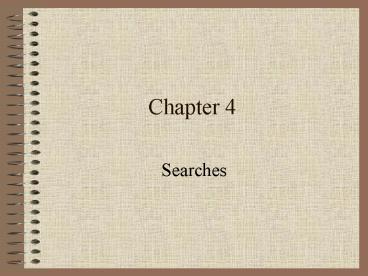Searches - PowerPoint PPT Presentation
1 / 19
Title:
Searches
Description:
An officer stops a suspicious person and believes the person may be armed ... This search is limited to the passenger compartment and containers therein ... – PowerPoint PPT presentation
Number of Views:50
Avg rating:3.0/5.0
Title: Searches
1
Chapter 4
- Searches
2
Fourth Amendment
- The right of the people to be secure in their
persons, houses, papers and effects, against
unreasonable searches and seizures, shall not be
violated, and no warrants shall issue, but upon
probable cause, supported by oath or affirmation,
and particularly describing the place to be
searched , and the persons or things to be seized
3
Conditions of a Legal Search
- A search warrant has been issued
- Consent is given
- An officer stops a suspicious person and believes
the person may be armed - The search is incident to a lawful arrest
- An emergency exists
4
Illinois v. Gates
- The test for probable cause under the Fourth
Amendment should be a totality of the
circumstances test - This case modified Aguilar v. Texas, and Spinelli
v. U.S.
5
A Search Warrant can be Issued for
- Stolen or embezzled property
- Property designed or intended for use in
committing a crime - Property that indicates a crime has been
committed or a particular person has committed a
crime
6
Illinois v. McArthur
- Police officers may detain residents outside
their homes until a search warrant can be
obtained if necessary - A police officers refusal to allow residents to
enter their homes without a police officer until
a search warrant was obtained was a reasonable
seizure that did not violate the Fourth
Amendment
7
Terry v. Ohio
- The Terry decision established that a pat-down or
frisk is a protective search for weapons and as
such must be confined to a scope reasonably
designed to discover guns, knives, clubs and
other hidden instruments for the assault of a
police officer or others - NOTE The officer may only pat-down for weapons
8
Florida v. J.L.
- The Court held that police could not stop and
frisk someone based on an anonymous tip
9
Chimel v. California
- A search incidental to a lawful arrest must be
made simultaneously with the arrest and must be
confined to the area within the suspects
immediate control - Immediate control means within the persons reach
10
Additional Cases
- N.Y. v. Belton (1981) established that the
vehicle of a person who has been arrested can be
searched without a warrant. This search is
limited to the passenger compartment and
containers therein - N.Y. v. Quarles (1984) a warrantless search in
the absence of a lawful arrest or consent is
justified only in emergencies or exigent
circumstances where probable cause exists and the
search must be conducted immediately - Mincey v. AZ. (1978) the Fourth Amendment does
not require police officers to delay a search if
to do so would gravely endanger their lives or
the lives of others
11
The Exclusionary Rule
- The exclusionary rule established that courts may
not accept evidence obtained by unreasonable
search and seizure, regardless of its relevance
to a case - Weeks v. U.S. (1914) made the rule applicable at
the federal level Mapp v. Ohio (1961) made it
applicable to all other courts
12
Related Principles
- Fruit of the Poisonous Tree Doctrine established
that evidence obtained as a result of an earlier
illegality must be excluded from trial - Good Faith Doctrine established that illegally
obtained evidence may be admissible if the police
were not aware they were violating a suspects
Fourth Amendment Rights
13
Goals of the Crime Scene Search
- Establish that a crime was committed and what the
specific crime was - Establish when the crime was committed
- Identify who committed the crime
- Explain how the crime was committed
- Suggest why the crime was committed
14
Crime Scene Search
- A true or uncontaminated crime scene is one that
no evidence has been introduced into it or taken
from it except by the person committing the crime
- The elephant-in-a-matchbox doctrine requires
that searchers consider the probable size and
shape of evidence
15
Search Patterns
- Exterior Searches
- Lane Search Pattern
- Strip Search Pattern
- Grid Search Pattern
- Circle Search Pattern
16
Search Patterns cont.
- Zone/Sector Search Pattern
- Interior Searches
- Starts at point of entry
- Floor first, then walls, then ceiling
- Move clockwise or counterclockwise around room
then search in opposite direction
17
Plain View Evidence
- U.S. v. Henry (1958) Unconcealed evidence seen by
an officer engaged in a lawful activity, is
admissible in court - U.S. v. Lueck (1982)
- Plain smell rationale
18
Other Types of Searches
- Building Searches
- Trash or Garbage Can Searches
- Allowable if trash is accessible to the public
- Restriction Curtilage-the portion of residence
not open to the public - Vehicle Searches
- Suspect Searches
- Dead Body Searches
19
(No Transcript)

